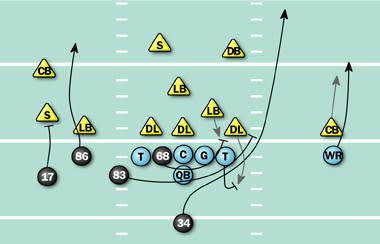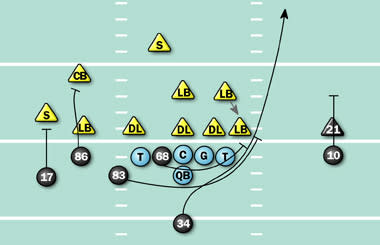Bunch formation will take pressure off QB
Also in this article:
Next Surveillance:
Dolphins
More NFL:
Editor's note: Yahoo! Sports will examine the biggest weakness of the 2009 season for every team and explain how the franchise can address the issue. The series continues with the Steelers, who finished third in the AFC North (9-7).
Biggest problem in 2009: An ineffective rushing attack

Ben Roethlisberger(notes) hands off to Rashard Mendenhall(notes).
(Karl Walter/Getty Images)
Through their championship years (and even in the years between), the Steelers have always been known as a team focused on running the ball. As we detailed in the Cardinals' Under Surveillance, the 2005 Steelers won the Super Bowl with the lowest single-season pass ratio of the past 25 years. But when they went back three years later for Super Bowl XLIII, they had changed into one of the league's highest pass ratio teams. The move from a 0.75 pass ratio to 1.23 in such a short time, bookended with Super Bowl wins, is virtually unheard of.
The most recent Super Bowl team had Ben Roethlisberger's elusiveness in the pocket as its primary trademark; by any standard, the team's offensive line had degraded severely over time. In 2009, the team's offensive line yards ranking was the highest (14th) it had been in years, but the Steelers were stopped at or behind the line of scrimmage on 20 percent of their running plays, which ranked 19th in the league. That's not generally good enough to get a team to the playoffs unless the passing game is firing on all cylinders. However, with Roethlisberger suspended for at least the first four games of the 2010 season, more must be expected of the running game. A sign of encouragement is that then second-year running back Rashard Mendenhall had a breakout season with 1,108 rushing yards on just 242 carries last season. And there is a schematic precursor to future rushing success, if the Steelers will use it more often.
The 2010 solution: Success comes in bunches
The Steelers have used the bunch formation, in which three receivers crowd together on one side of the field, as much as any other team for pass plays. One great wrinkle they've advanced in recent seasons is the use of bunch formations in the running game. The Steelers will frequently put two receivers, or two tight ends and a receiver, in the bunch and use those players to help with blocking. Always in the bunch is receiver Hines Ward, long recognized as the NFL's best blocker at his position. According to Football Outsiders, the Steelers gained 197 yards on 36 carries (a 5.5 per-carry average) from the bunch formation in 2009, and the two most productive plays came against the Broncos in Week 9.

Figure 1
The first play came with 10:29 left in the third quarter and the Broncos leading 10-7. Pittsburgh had first-and-10 at its own 38-yard line. The Steelers had a bunch left (Fig. 1) with Ward (86), receiver Mike Wallace (17) and tight end Heath Miller (83) in the set. At the snap, Ward and Wallace ran straight routes, while Miller and left guard Chris Kemoeatu (68) pulled right and sealed the right edge. Because left end Le Kevin Smith used a pass-rush move, Mendenhall (34) was able to hit the gap between Smith, who was trying to recover and peel back to stop Mendenhall, and the blocked-off edge. Once that happened, Mendenhall ran outside right for a 24-yard gain.

Figure 2
The second play happened a few minutes later, with 6:05 left in the third quarter and the Steelers with first-and-10 at their own 20. Pittsburgh lines up in the same basic structure (Fig. 2), and the Broncos put eight in the box this time. But because the blocking was set so well, it didn't matter that everyone on the field probably knew what was coming. Kemoeatu and Miller took the same angles, sealed the edge, and Mendenhall ran right again. This time, Mendenhall bounced off the right edge, took off beyond some great blocking by receiver Santonio Holmes (10) on cornerback Andre Goodman (21), and motored for 28 yards.
The Steelers use bunch formations in many different ways – they'll run against the formations with blocking pulls as detailed here. They'll send their running backs straight behind a bunch right, and they love to use clear-out patterns in the passing game, in which the trio of receivers will run complementary routes to get quick openings for the quarterback du jour. As the Steelers try to keep pace with the Ravens and Bengals in the AFC North without Roethlisberger, they'll need to find different ways to make more consistent gains on the ground.
